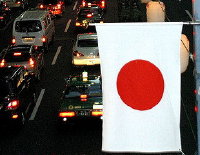Japan’s research community and MIT Sloan Management Review
 A restaurant in Brookline, Mass., which specializes in local and regional American food and has no obvious tie to Japan, has hung a Japanese flag in its window. It’s a small sign of empathy on this side of the world as we watch the horrors that are unfolding on the other side.
A restaurant in Brookline, Mass., which specializes in local and regional American food and has no obvious tie to Japan, has hung a Japanese flag in its window. It’s a small sign of empathy on this side of the world as we watch the horrors that are unfolding on the other side.
At this time when we all feel sadness and concern for the people of Japan, we want to take a moment to express our appreciation for some of the ways in which Japanese researchers — and Japanese management innovations — have contributed to MIT Sloan Management Review over the years.
Many of the stories written by these contributors have provided insight into Japanese methods of manufacturing, with lessons about partnership, motivation, and innovation.
Ikujiro Nonaka, at the time a professor and director of the Institute of Business Research, Hitotsubashi University, wrote a story in 1988 on “middle-up-down management” and the concept of “compressive management,” which recognizes a key role for middle managers in information development. His work was assisted by professor Hirotaka Takeuchi and Tsuyoshi Numagami of Hitotsubashi University.
Toshihiro Nishiguchi, at the time a professor of management at Hitotsubashi University, Institute of Innovation Research, co-authored an important story with Alexandre Beaudet, then a research adviser at the Mitsubishi Research Institute, on the Toyota Group and a 1997 fire at a supplier, Aisin Seiki. The story detailed how a group of suppliers “demonstrated its cohesion and resiliency at a time when many observers were discussing the weakening of traditional ties among group members,” banding together to set up alternative production sites and continue to supply a crucial part to Toyota.
MIT SMR has, in fact, had numerous stories about the management lessons of Toyota that were made possible by the assistance and generosity of Japanese researchers, data gatherers, and managers. Among those pieces:
- 1995’s “The Second Toyota Paradox: How Delaying Decisions Can Make Better Cars Faster” by Allen Ward, Jeffrey K. Liker, John J. Cristiano and Durward K. Sobek II;
- 1999’s “Toyota’s Principles of Set-Based Concurrent Engineering” by Durward K. Sobek II, Allen C. Ward and Jeffrey K. Liker;
- 2009’s “Toyota’s Secret: The A3 Report” by John Shook, the American who was hired in late 1983 to work on the Toyota side of its new venture with GM, assigned to a newly formed group at the company’s Toyota City headquarters in Japan to develop and deliver training programs to support its impending overseas expansion (this story includes an introduction by MIT SMR editor Michael S. Hopkins);
- 2010’s “How to Change a Culture: Lessons From NUMMI,” also by Shook, about what actually happened when Japanese ideas were brought to the U.S. GM plant that “was considered to be an extraordinarily ‘bad’ one.”
Susumu Ogawa, a professor of marketing at the Graduate School of Business Administration at Kobe University in Kobe, co-authored with Frank T. Piller of the TUM Business School, Technische Universität München, a story about reducing the risks of new product development, and listed Hidehiko Nishikawa and Kohei Nishiyama in the acknowledgements for their input. Kazuhiro Asakawa, professor at Keio University’s Graduate School of Business Administration, co-authored the paper “R&D Collaborations and Product Innovation,” which we summarized in “Collaborating With the Right Partners.”
Garr Reynolds, an associate professor of management at Kansai Gaidai University in Japan and the author of the popular design blog, spoke to MIT SMR two years ago about how to be a better manager by thinking like a designer.
Today at his blog Presentation Zen, four days after the Japanese earthquake and tsunami, Reynolds writes, “When I first moved to Japan 22 years ago I lived in the Shimokita Hanto in Northern Japan and stayed in many small towns and fishing villages that are quite similar to the ones that were destroyed in the Tsunami near Sendai. I also visited Tohoku University many years ago and visited Sendai several times in those early years. Sendai is a lovely small city surrounded by beautiful nature. Japan is my favorite place in the world; I love this land and this culture so much. It’s a special place like no other. That’s why this country will be my home for as long as I am alive. And to see its people suffering up north now is too sad for words.”
Reynolds also writes, “The pain must be unbearable. The pain is shared by every single person here in Japan. Our hearts are with the people of Tohoku and our prayers go out to them.”
We share that sentiment. Our hearts are with the people of Japan.
Donations to Japan can be made online at the Red Cross or, in the U.S., by texting REDCROSS to 90999 to donate $10.
— The staff of MIT Sloan Management Review
